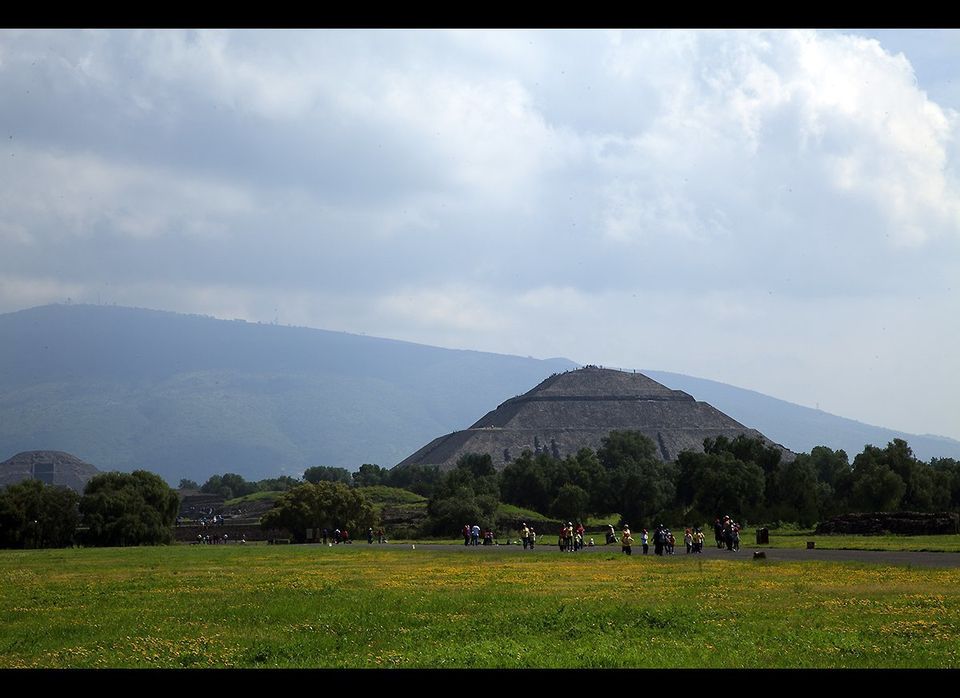Photos by Paul Ross
People who visit Teotihuacan, outside of Mexico City, for the first time, often wonder if it was built by aliens. How else could humans who had nothing but stone tools construct a city with broad avenues, a main street that points to astronomical north, huge stone pyramids aligned to the sun and moon, and carvings that evoke the gods, the underworld and the mysteries of cultural cosmology?
Teotihuacan is considered by many people to be the most important pyramid complex in pre-Colombian America. Even if you have been there in the past, it's exciting to go again, to see what is "new" in the ancient ruins of what was once the Rome, Paris or Washington D.C. of its day. According to our guide, Jorge Archer, a physical anthropologist who has worked on and remains actively engaged with the site, the founders were traders, and important commercial routes passed through the city. One of their key "exports" was obsidian, which was used to make blades that were supposed to be five times sharper than a surgeon's scalpel. And they jealously guarded the trade secrets of how to make the coveted knives that were used for cooking, scraping and warfare, and were in high demand.
By around 100 C.E., a well-planned city began to emerge, and the construction of the famed pyramids of the sun and moon was underway. By 300 C.E., the sprawling city probably extended over 20 square kilometers. In about 1200 C.E., the nomadic Aztecs came through the largely abandoned site. They saw the massive stone structures and thought the gods had built it. In their language, Teotihuacan means "city of gods."
What we see today is the base of the pyramids that were built to replicate sacred mountains. When the city was occupied, there were temples on top of the pyramids. Today only one temple remains, and a large portion of Teotihuacan has been reconstructed so visitors can imagine what it once looked like -- minus the paintings on plaster and the floors that once graced the buildings.
Almost every day there are discoveries by archeologists and specialists who continue to work at the site, and Jorge shared a number of them with us. In fact, instead of beginning at the iconic temples of the sun and moon, he suggested that we start our visit near the Feathered Serpent Temple, in an area known as the "citadel." It was probably once the prime ceremonial center, and there are perhaps six or seven earlier cities underneath the ground. So as you walk around, you are quite literally walking on history.
The vast citadel "plaza" could probably accommodate 95,000 standing people during ceremonies and public events. What was once known as the Quetzalcoatl temple is now called the Feathered Serpent Temple. And experts think there was another temple nearby, with elaborate bird sculptures. Something happened in Teotihuacan in ancient times, and the Feathered Temple was destroyed and the new one built. Specialists are also rethinking the figures on the Feathered Serpent Temple. In the past, it was assumed that they represented the god Tlaloc, but now it has become apparent that the so-called Tlacoc sculptures have scales and round eyes that represent water and jade stone. So the figures may well be crocodiles instead of Tlalocs.
Most of the human sacrifices at Teotihuacan took place in the citadel area, with 20 unfortunates sacrificed before the construction of the Feathered Serpent Temple. Their throats were cut with an obsidian knife, and their blood fed the gods and sanctified the temple before its construction. Even more surprising is the discovery that the plaza was covered with waterproof flooring. It was flooded to recreate or re-enact a seminal creation event when their sacred mountain emerged from the water.
Do not leave Teotihuacan without visiting Tepantitla, one of the 2,000 housing compounds that once surrounded the main areas of the city and vibrated with life. There is speculation, according to Jorge, that a house we visited belonged to priest. All of the houses at Teotihuacan were constructed the same way, according to mandated ancient building codes, which included a complicated drainage system designed to conserve water, a patio for ceremonies, and flooring. When I bent down to touch the floor, it felt like polished marble.
What sets Tepantitla and the house of the priests apart are the magnificently preserved murals, which are unlike any others I have seen in the Maya world. They are polychrome, cartoon like, and one wall depicts men talking, playing a ballgame with what looks like long hockey sticks, another game with what seem to be marbles or tiny balls, and interacting in their daily lives. On another wall, the women are doing all the work -- planting and laboring in the fields that fed their families.
We were so captivated by Jorge's behind-the-scenes-and-what's-the-latest tour that we had no time left to climb up the pyramids of the sun and moon. But we were not at all disappointed!
Judith Fein is an award-winning travel journalist who has contributed to more than 100 publications. She is a speaker, workshop leader, author of the book LIFE IS A TRIP: The Transformative Magic of Travel, and her website is www.GlobalAdventure.us
